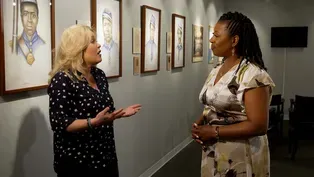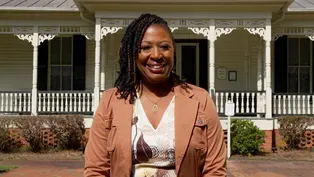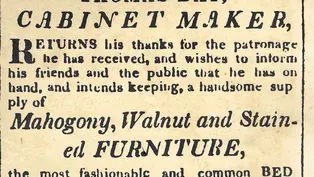
Oberlin Rising
Clip: Season 21 Episode 21 | 6m 1sVideo has Closed Captions
Deborah Holt Noel traces the revitalization of the Black Oberlin neighborhood in Raleigh.
Deborah Holt Noel traces the revitalization of the Black Oberlin neighborhood in Raleigh.
Problems with Closed Captions? Closed Captioning Feedback
Problems with Closed Captions? Closed Captioning Feedback
North Carolina Weekend is a local public television program presented by PBS NC

Oberlin Rising
Clip: Season 21 Episode 21 | 6m 1sVideo has Closed Captions
Deborah Holt Noel traces the revitalization of the Black Oberlin neighborhood in Raleigh.
Problems with Closed Captions? Closed Captioning Feedback
How to Watch North Carolina Weekend
North Carolina Weekend is available to stream on pbs.org and the free PBS App, available on iPhone, Apple TV, Android TV, Android smartphones, Amazon Fire TV, Amazon Fire Tablet, Roku, Samsung Smart TV, and Vizio.
Providing Support for PBS.org
Learn Moreabout PBS online sponsorshipIf you've ever driven along busy Oberlin Road in Raleigh, you may have noticed five enormous structures seemingly rising out of the earth.
Well, those sculptures actually represent a historically black neighborhood that was established back in the late 1800s, and some of the special people who emerged from it.
One of them is actually my own father.
Join me on a visit to Oberlin Rising.
- [Howard] Black makers fired the flame that fashioned this place.
$50 for a parcel of dream measured out by the acre.
Hear the hammer.
Boards banged into place.
Bricks slapped with mortar.
The Draymond's horse.
Clap, clap, clapping and pulling cart.
With supplies for 750 pioneers of the possible.
- [Smedes] I grew up in Raleigh, pretty much on Craig Street where I live now.
Cameron Village was developed by my father, and so Oberlin is right between my home and Cameron Village.
I really felt a kindred to that section of Oberlin my entire life.
I always thought we need to have a sculpture there.
- [Deborah] It's here on Oberlin Road in Raleigh, where Developer, Smedes York wanted a reason for passersby to stop and reflect on a special community whose homes once stood where his business now stands.
The community that came to be called Oberlin began as 16 acres of land purchased in 1858 by a free black man named, Jesse Pettiford.
Many formerly enslaved people purchased lots from surrounding property as well, and the community grew.
This beginning Marks Oberlin as the only freedman's village in North Carolina with roots as a free black settlement.
To develop the idea of a sculpture park honoring the memory of Oberlin Village, York gathered input from Oberlin residents, and enlisted the talents of his dear friend, Thomas Sayre.
A visionary North Carolina artist renowned for crafting monumental captivating sculptures.
- Oberlin Rising is primarily a sacred space.
It's the place where a vibrant community was for a number of years and it still is.
The goal was to hold the history of that place, and the spirit of that place up for people to come to now, and remember it and not forget it.
- [Deborah] For inspiration, Sayre attended listening sessions with the Oberlin residents, and considered their recollections of a home that produced a black middle class who treasured education, family and progress.
Oberlin was home to Latta University, founded by Reverend M.L.
Latta in 1892, but whose final remnant was destroyed by fire in 2007.
From Oberlin, also arose some prominent people.
- Dr. James E. Shepherd, who founded What we now know as North Carolina Central University is a product of Oberlin.
John H. Baker, Jr.
I think he served more consecutive terms as Sheriff of Wake County than anyone else.
Dr. William B. Pettiford.
Dr. Peter Roberts and Dr. Charles Haywood who was a dentist.
And I guess there must have been about 20 healthcare professionals who were nurses in the life.
- [Deborah] Joe Holt himself emerged as a pioneer in civil rights as the central figure in the first effort to integrate Raleigh public schools.
Sayre design would inspire curiosity, and figuratively reference the story of Oberlin.
- There's the shadow of three structures that people lived in, and then the up surface is a trial surface that we could imprint.
And so I made tools that express the different kinds of skills that the community was known for.
Masons.
And so there's a trow shape.
There's a gavel that refers to the professionals seamstresses, and shirt launderers.
And so there's a kind of a weaving pattern about cloth.
- [Howard] Masons, carpenters, seamstresses, schoolteachers, transformed, peck's place and save rent into a mighty village.
Rising.
- [Deborah] The park would communicate the work of those laborers who made Oberlin and left legacy.
A return wall would carry the message through the depiction of many hands cast from the hands of Oberlin's descendants.
One of them the hands of Joe Holt's granddaughter, who is my daughter.
Local Poet, Howard Craft, would capture Oberlin's spirit in prose.
- Take the time to read the plaques that are there.
Howard Craft did a very good job of composing some poetry that tells about the community.
- [Deborah] And the flora of Oberlin would not be forgotten.
- A lot of the plants that were chosen were chosen because they are plants that people remember having on the street, and having in their yards.
I really wanted to have plants that are bold and resilient.
And so we have, you know, of 10 or 12 plum trees out there that have been providing fruit for years now.
- [Howard] As you stand here or sit and gaze, and breathe in the history of this place, know it was born of sacrifice and struggle, and it was made and is made from the lives of people who loved and lived and still do.
- [Thomas] Oberlin Rising is one of the more important projects I've ever done.
I'm not sure the City of Raleigh knew how important it was at first, but I think it does now.
- [Deborah] Oberlin Rising Sculpture Park is located at 809 Oberlin Road in Raleigh, and it's open to visitors year round.
For more information about the history of Oberlin, visit the Friends of Oberlin website at FriendsofOberlinVillage.org.
Video has Closed Captions
Relive your childhood playing vintage arcade games in Forest City. (4m)
Video has Closed Captions
The Museum of the Cape Fear displays the history of the Fayetteville area. (4m 44s)
Video has Closed Captions
Join us as we head to notable historic sites and destinations across the state. (26s)
Thomas Day State Historic Site
Video has Closed Captions
Learn about early furniture maker Thomas Day at this new site in Milton. (5m 10s)
Video has Closed Captions
We explore Fort Defiance, a home built by Revolutionary War hero William Lenoir in 1792. (3m 40s)
Providing Support for PBS.org
Learn Moreabout PBS online sponsorshipNorth Carolina Weekend is a local public television program presented by PBS NC
















